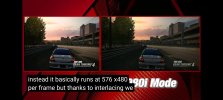By: James Mielke April 2, 2002 6:46 PM PST
While most people are content to plug their video game consoles in with the standard RCA cables (or, god forbid, with RF adapters), some swing to the higher end of audio-visual mayhem and prefer their games in as high a resolution as they can get. This usually means using either S-video, or optimally, component cables. Then, for folks who have the luxury of watching their movies on a progressive scan-enabled television, you have to have a progressive scan-enabled DVD player.
Take a look at this story for more on the specifics of progressive scan technology
Since the PS2 is a DVD player, you may have wondered if your PS2 can do progressive scan output. While the PS2 isn't currently equipped to do so, we're still glad to confirm that, yes, it can.
To get the full poop, we contacted Seth Luisi, producer on SOCOM: Navy Seals, over at Sony to see what he had to say on the subject. Word up, yo!
"The PS2 can indeed output in progressive scan and the new Sony Libraries that were just released allow PS2 developers to do Anamorphic Widescreen Progressive Scan output in their games. Actually, Tekken4, which was just released in Japan, is the first PS2 game with progressive scan output.
"We are actually considering adding progressive scan output to SOCOM but we may not be able to do to our tight schedule. In order to do progressive scan output you need to run with a full size frame buffer, not a half size frame buffer that is interlaced, which is what a lot of PS2 games use in order to save VRAM. In order to realistically use a full size frame buffer you have to use dynamic texturing and store a lot of your textures in main RAM, which is the method that SOCOM and most advanced 3rd generation PS2 games will use.
"Dynamic texturing has many pluses besides just allowing a full size frame buffer and progressive scan output. With dynamic texturing, the amount VRAM in the PS2 does not matter because you are only using it as a texture cache, as it was meant to be used. We use over 4MB of textures for our character models in SOCOM alone, even though the PS2 only has 4MB of VRAM. The textures are swapped into and out of VRAM every game frame (1/60th or 1/30th of a second) which the PS2 can do since it has such fast memory access.
"Regarding DVD playback, I am not certain it will be included in the future. However, it is definitely possible and since SCEI has made Anamorphic Widescreen Progressive Scan output available for game it only makes sense to add it to the next release of the DVD Drivers."


